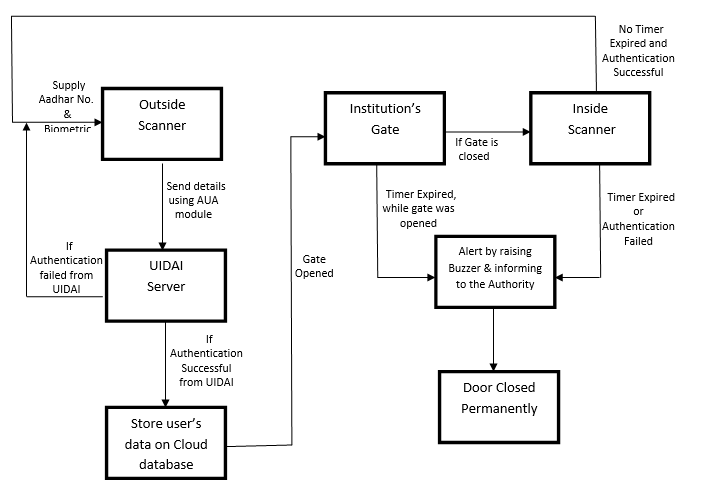IOT based Security System for Auto Identifying Unlawful Activities using Biometric and Aadhar Card
Main Article Content
Abstract
In today’s era, where thefts are consecutively increasing, especially in banks, jewelry shops, stores, ATMs, etc, there is a need to either develop a new system or to improve the existing system, due to which the security in these areas can be enhanced. However, the traditional methods (CCTV cameras, alarm buttons) to handle the security issues in these areas are still available, but they have lots of limitations and drawbacks. So, in order to handle the security issues, this paper describes how the biometric and IoT (Internet of Things) techniques can greatly improve the existing traditional security system. Our proposed system uses biometric authentication using the fingerprint and iris pattern with the strength of IoT sensors, microcontroller and UIDAI aadhar server to enhance the security model and to cut the need of keeping extra employees in monitoring the security system.
Article Details

This work is licensed under a Creative Commons Attribution-NoDerivatives 4.0 International License.
References
Sri Shimal Das, S. J. (2011). Designing a Biometric Strategy (Fingerprint) Measure for Enhancing ATM Security in Indian E-Banking System. International Journal of Information and Communication Technology Research.
Anil K. Jain, K. N. (2012). Biometric Authentication: System Security and User Privacy. Identity Science (IEEE).
Suman Sengupta, T. S. (2013). IRIS Texture Analysis, Finger Printing and Signature Verification for Automatic Data Retrieval System using Biometric Pattern Recognition System. International Journal of Advances in Computing and Management.
Ambika Arora, A. S. (2014). Bank Locker System with IRIS Enrollment Security. International Journal of Engineering & Scientific Research (IJESR).
Prof. R. Srinivasan, T. M. (2015). Advanced Locker Security System. International Conference on Information Engineering, Management and Security (ICIEMS).
Narmatha. K, A. R. (2016). Security for ATM Machine using Aadhar Card, IRIS Scanner and IOT. International Journal of Engineering Science Invention Research & Development.
Aravinth. J, G. P. (2016). Bank Locker Security System using IOT. IOSR Journal of Computer Engineering (IOSR-JCE) .
Dhvani Shah, V. B. (2016). IOT Based Biometric Implementation on Raspberry Pi. ScienceDirect (Elsewire).
Annies Joshy, J. M. (2017). Design and Implementation of IOT based Secure Biometric Authentication System. IEEE Spices.
Sandip Dutta, N. P. (2018). Microcontroller based Bank Locker Security System using IRIS Scanner and Vein Scanner. Proceedings of International Conference on Inventive Research in Computing Applications (ICIRCA).
Satvik Gogineni, K. M. (2018). IOT based Centralized Bank Security System for Monitoring and Auto Arresting. Research India Publications.
J.S. Vimali, S. S. (2019). IOT based Bank Security System. International Journal of Recent Technology and Engineering (IJRTE).
Wencheng Yang, S. W. (2019). A Privacy Preserving Lightweight Biometric System for Internet of Things Security. IEEE Communication Magazine.
Choudhary, G. M. (2019). Biometric Authentication in Internet of Things: A Conceptual View. Journal of Statistics and Management Systems.
J. Thirumalai, G. R. (2020). An IOT based bank locker security sytem. Journal of Engineering Research and Technology (IJERT).
Dnyaneshwari P. Wagh, H. F. (2020). Biometric Finger Vein Recognition Methods for Authentication. Springler Nature Singapore Pte Ltd.
Arvasu Chikara, P. C. (2020). Smart Bank Locker using Fingerprint Scanning and Image Processing. International Conference on Advanced Computing & Communication System (ICACCS).
Shweta Agrawal, S. B. (n.d.). Privacy and Security of Aadhar: A Computer Science Perspective.

